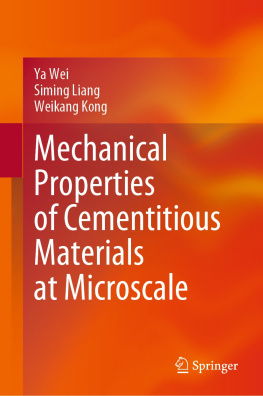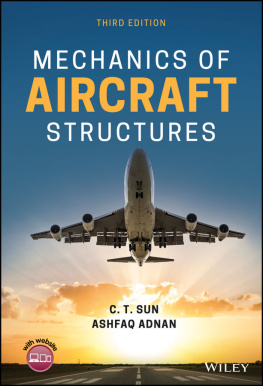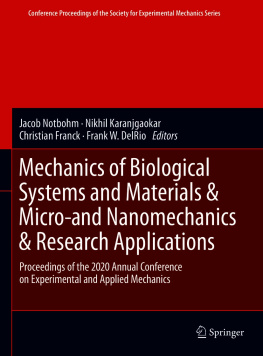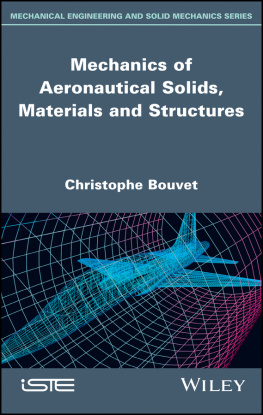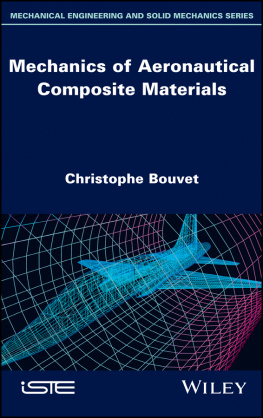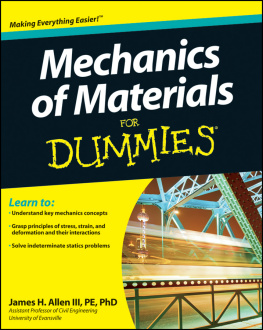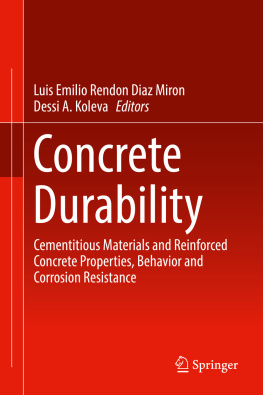Pijaudier-Cabot Gilles - Damage Mechanics of Cementitious Materials and Structures
Here you can read online Pijaudier-Cabot Gilles - Damage Mechanics of Cementitious Materials and Structures full text of the book (entire story) in english for free. Download pdf and epub, get meaning, cover and reviews about this ebook. City: London;Hoboken;N.J, year: 2013;2012, publisher: John Wiley & Sons, Incorporated;ISTE Ltd, genre: Home and family. Description of the work, (preface) as well as reviews are available. Best literature library LitArk.com created for fans of good reading and offers a wide selection of genres:
Romance novel
Science fiction
Adventure
Detective
Science
History
Home and family
Prose
Art
Politics
Computer
Non-fiction
Religion
Business
Children
Humor
Choose a favorite category and find really read worthwhile books. Enjoy immersion in the world of imagination, feel the emotions of the characters or learn something new for yourself, make an fascinating discovery.
- Book:Damage Mechanics of Cementitious Materials and Structures
- Author:
- Publisher:John Wiley & Sons, Incorporated;ISTE Ltd
- Genre:
- Year:2013;2012
- City:London;Hoboken;N.J
- Rating:4 / 5
- Favourites:Add to favourites
- Your mark:
- 80
- 1
- 2
- 3
- 4
- 5
Damage Mechanics of Cementitious Materials and Structures: summary, description and annotation
We offer to read an annotation, description, summary or preface (depends on what the author of the book "Damage Mechanics of Cementitious Materials and Structures" wrote himself). If you haven't found the necessary information about the book — write in the comments, we will try to find it.
Damage Mechanics of Cementitious Materials and Structures — read online for free the complete book (whole text) full work
Below is the text of the book, divided by pages. System saving the place of the last page read, allows you to conveniently read the book "Damage Mechanics of Cementitious Materials and Structures" online for free, without having to search again every time where you left off. Put a bookmark, and you can go to the page where you finished reading at any time.
Font size:
Interval:
Bookmark:

First published 2012 in Great Britain and the United States by ISTE Ltd and John Wiley & Sons, Inc.
Apart from any fair dealing for the purposes of research or private study, or criticism or review, as permitted under the Copyright, Designs and Patents Act 1988, this publication may only be reproduced, stored or transmitted, in any form or by any means, with the prior permission in writing of the publishers, or in the case of reprographic reproduction in accordance with the terms and licenses issued by the CLA. Enquiries concerning reproduction outside these terms should be sent to the publishers at the undermentioned address:
| ISTE Ltd 27-37 St Georges Road London SW19 4EU UK | John Wiley & Sons, Inc. 111 River Street Hoboken, NJ 07030 USA |
| www.iste.co.uk | www.wiley.com |
ISTE Ltd 2012
The rights of Gilles Pijaudier-Cabot and Frdric Dufour to be identified as the author of this work have been asserted by them in accordance with the Copyright, Designs and Patents Act 1988.
Library of Congress Cataloging-in-Publication Data
Damage mechanics of cementitious materials / edited by Gilles Pijaudier-Cabot, Frederic Dufour. p. cm.
Includes bibliographical references and index.
ISBN 978-1-84821-340-1
1. Concrete--Deterioration. 2. Fracture mechanics. I. Pijaudier-Cabot, Gilles. II. Dufour, Frederic.
TA440.D285 2012
620.1'36--dc23
2011044636
British Library Cataloguing-in-Publication Data
A CIP record for this book is available from the British Library
ISBN: 978-1-84821-340-1
This book is prepared in honor of the retirement of Prof. Jacky Mazars, following a workshop held in Schladming (Austria) in March 2010 under the auspices of Oxand SA with whom Jacky has been closely related recently.
Mazars graduated in 1972 from Ecole Normale Suprieure de lEnseignement Technique in Cachan. He obtained what was at that time the highest degree at the university, the thse de Doctorat dEtat, from the University of Pierre and Marie Curie Paris in 1984.
His association with Ecole Normale Suprieure de lEnseignement Technique, which later on became Ecole Normale Suprieure (ENS) de Cachan, has played a pivotal role in his scientific career and also had a major impact on the scientific community in civil engineering. It was at the beginning of his career that continuum damage mechanics took off in France under the impulse of Prof. Jean Lemaitre. Mazars took on his share of this job, applying the principles of continuum damage modeling to concrete. His pioneering doctoral thesis is the angular block on which many scientists in civil engineering built their career and research activities.
During the 1980s, Mazars directed the research group at the Laboratoire de Mcanique et Technologie in Cachan. He has been at the origin of research in Civil Engineering in Cachan and his group, with others in Paris and in Lyon, took the leadership in computational mechanics of concrete structures in France. At that time, research in civil engineering emerged with the help of CNRS within the GRECO Gomatriaux, and Cachan became a major contributor to this collaborative network. It was also in Cachan that the workshop on Damage and Strain Localization was held in 1988, co-chaired by Zdenk Baant and Jacky Mazars. Strain and damage localization was a very hot topic at that time and this workshop contributed a lot to the international recognition of the French school on this subject.
The involvement of Mazars at ENS de Cachan has not been limited to research. After being promoted to full professor in 1989, he took on the chairmanship of the Civil Engineering department in 1990 and created the Masters in Civil Engineering at Cachan. Very soon this Masters program became a reference, due not only to the quality of the research and teaching environment, but also to the close links that Jacky contributed to create and enrich with major French-speaking universities: Laval and Sherbrooke in Qubec, Lige in Belgium, and Ecole Polytechnique Fdrale in Lausanne. This Masters program and the specificity of ENS, a school entirely devoted to the formation of professors and researchers, created the best conditions for a number of cooperation programs leading to joint PhDs and to international research programs (European programs, Nato sponsorship, France-Berkeley funds, etc.). In 1995, Mazars became the Deputy Director of ENS Cachan. This time it was ENS at large that benefited from his energy and his involvement toward a solid and equilibrated development of research and academic programs. For sure, Jacky did not withhold his time and effort for the benefits of all the faculty staff and students in Cachan.
During the 1990s, after a strong cooperation with EDF related to thermo-hygro-mechanical-coupled effects in concrete dams, Jackys interests in research shifted from durability problems to earthquake engineering; he promoted very important research programs on the new shaking table at CEA Saclay (CASSBA, CAMUS, etc.) and in the framework of JRC Ispra networks. He also became the vice-president of the French Association of Earthquake Engineering (AFPS).
The year 2000 was a turning point in Jackys career. He moved to Grenoble at the Institut National Polytechnique and geared his research activities toward risk assessment and vulnerability of structures. He created the federation of laboratories VOR (vulnerability of structures against risks) and started an association with the Ministry of Defense DGA dealing with the dynamic response of concrete structures. This partnership brought the Giga testing machine in Grenoble, a unique piece of equipment from which very original research results have been obtained and many others are expected. Mazars became the Director of the Laboratoire Sols, Solides, Structures and Risques (3S-R) in 2003. He left this position when he became Professor Emeritus at the end of 2009.
Mazars has contributed with key results in constitutive modeling of structural concrete, dynamic, and seismic response of concrete structures, durability and experiments under very high confinement pressures. He belongs to the group of leading experts in these fields in France and in the international community. He has directed many national and international projects and is on the advisory committee of several scientific journals. He has supervised 32 PhD candidates and written over 40 peer-reviewed papers. Jackys motivation for research and teaching (he is still a Professeur associ at Sherbrooke University) has always been close to industrial and practical issues. This is an outstanding quality, not a simple idea but a spirit put to practice. He is recognized as an expert by EDF for nuclear infrastructures and this is also what has been behind his involvement with Oxand over the past years, just to put the ideas at work.
Our first idea was to conceive the workshop in Shladming as a friendly gathering aimed at honoring Mazarss achievements. After the workshop, however, and in view of the quality and the wide scope of the various talks from the invited speakers, we thought that we should grasp the opportunity of assembling a volume dedicated to the recent advances in the spectrum covered by Jackys involvement in research. The keyword in this involvement is certainly damage mechanics applied to cementitious materials and more importantly to civil engineering structures. This is exactly the road map of this volume, starting with considerations at the molecular level in the first two chapters and ending with applied case studies on industrial or full-scale structures. In between, fracture and damage of concrete is certainly the link. Modern issues dealing with size/scale effects, deterministic and probabilistic failure models, advanced constitutive modeling, and computational schemes are addressed, providing henceforth a panorama of outstanding recent achievements in the modeling of concrete and concrete structures.
Font size:
Interval:
Bookmark:
Similar books «Damage Mechanics of Cementitious Materials and Structures»
Look at similar books to Damage Mechanics of Cementitious Materials and Structures. We have selected literature similar in name and meaning in the hope of providing readers with more options to find new, interesting, not yet read works.
Discussion, reviews of the book Damage Mechanics of Cementitious Materials and Structures and just readers' own opinions. Leave your comments, write what you think about the work, its meaning or the main characters. Specify what exactly you liked and what you didn't like, and why you think so.


